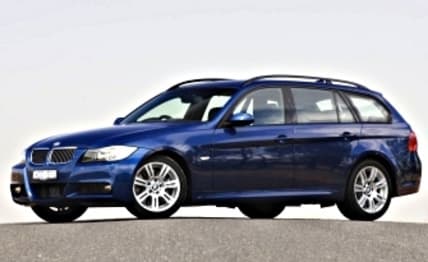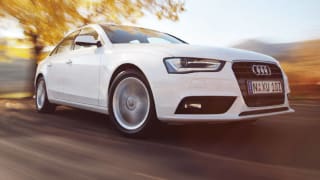Europe's latest new-car wave mimics athletes evolving over consecutive Olympic Games to be lighter and faster than predecessors.
The BMW 320i reflects the direction - bigger cars with smaller engines and more features yet with even perkier performance. It's a philosophy that's easy to understand but the mandate is so specific that we now have three German car makers with almost identical drivetrains.
No surprises that Audi in June launched its A4 mid-size saloon to ward of BMW's long-awaited 3-Series sedan and the impressive Mercedes C-Class. Splitting these three is very difficult.
Value
BMW in the old days used to charge a fortune for stuff the Japanese threw in for free. Times change as BMW now meets its rivals head on. The 320i is the second cheapest 3-Series but gets dual-zone climate control, cruise control with brake function, electric front seats with memory, keyless start and entry, front and rear park sensors, Bluetooth and a six-speaker audio with iPod and USB connectivity.
At $57,600, it's pretty good value and yet is lineball with Audi and Mercedes. Of course, there is an exhaustive list of options starting with the test car's $3152 Sport Line kit (17-inch alloys, sports seats, leather and a few other items), sunroof ($2245), upgraded sat-nav ($1538) and metallic paint (over t he top at $1415). That makes $65,950 plus onroad costs.
Design
Noticeably bigger in length (by 93mm) and on a 50mm longer wheelbase, the 3-Series sedan offers a lot more cabin room - especially for rear passengers - and a boot that is up 20 litres to 480 litres and increased flexibility via a 40/20/40 split rear folding seat. Bigger doors help entry and exit, too. The 3-Series also looks more sporty and more difficult to differentiate from a 5-Series.
The grilles are wider, lower and canted sli ghtly forward while there's now twin headlights. The extra width is reinforced by the wider track (up 37mm at the front and 47mm at the back) which promotes a flat stance. The cabin has a cleaner dash with an instrument panel with four gauges, and the centre 165mm monitor is better placed for driver visibility and reads audio, entertainment, communication and navigation functions. The once awkward iDrive has pre-programmable favourite buttons for easier use.
Technology
All BMW 3-Series have tur bocharged engines. The 320i is the cheapest petrol model (the 318d is a diesel) and uses a 2-litre 135kW/270Nm four-cylinder turbo-petrol engine that is up 20kW/70Nm on its predecessor yet cuts fuel use by 21 per cent to 6 L/100km and trims the 0-100km/h sprint by 2.2 seconds to 7.6 seconds. This cleverness typifies what I alluded to in the start of this article.
The gearbox is a sweet eight-speed automatic and the chassis retains all the solid, driver-focussed technology - multi-link suspension and rear-wheel drive included - for which BMW is renown. The 320i also gets standard brake energy regeneration, electric-assist power steering, stop/start technology and "Driving Experience Control'' that allows the driver to select four modes to customise the steering, engine, transmission and stability control response.
They are dubbed Comfort, Sport, Sport+ and EcoPro that are selected via a rocker switch on the centre console. An optional Adaptive M Suspension ($2200) varies the dampers fo r characteristics between comfort and sport.
Safety
All 3-Series are five-star crash-rated cars. There are six airbags, driving aids - electronic stability and traction control, cornering control and brake assist. There's also a new active protection system that initiates protective measures - such as readying the brakes - if an accident is imminent. The 320i adds front and rear park sensors and automatic headlights and wipers. There's no spare wheel as it has run-flat tyres.
Driving
The larger size of the 3-Series in its sixth generation is a bit of a shock. But it looks better and less than one hour in the driver's seat, goes better. Its ride is slightly more supple than the outgoing model, thanks mainly to the longer wheelbase and further updates on the run-flat tyres.
All models above the base 320d have a four-mode program for engine, steering and transmission response but it doesn't change the suspension dampening - that's a $2200 option called Adaptive M-Sport. Start the test w ith the "Comfort'' setting on the program and performance is, honestly, average. Hit the "EcoPro'' setting and it all turns to treacle.
The lethargy improves fuel efficiency but at the cost of the 320i feeling like it's lost a cylinder. But the "Sport'' and "Sport+'' buttons return the 320i to what the car should be - a responsive, quick and very enjoyable drive. Sometimes fuel efficiency is over-rated. I love the handling of this car and even the electric-assist steering works so well with the chassis.
But the engine, clever though it is, sounds harsh at idle. The gearbox is delightful in its action and the paddle shifts just enforce the car's sporty nature. The extra room in the back seat is appreciated, though I'm all too aware that it's moving so close to the 5-Series in size.
Verdict
A fun drive when the right buttons are pushed but do we really need the extra centimetres in its length?











